ETS models¶
The ETS models are a family of time series models with an underlying state space model consisting of a level component, a trend component (T), a seasonal component (S), and an error term (E).
This notebook shows how they can be used with statsmodels. For a more thorough treatment we refer to [1], chapter 8 (free online resource), on which the implementation in statsmodels and the examples used in this notebook are based.
statsmodels implements all combinations of: - additive and multiplicative error model - additive and multiplicative trend, possibly dampened - additive and multiplicative seasonality
However, not all of these methods are stable. Refer to [1] and references therein for more info about model stability.
[1] Hyndman, Rob J., and George Athanasopoulos. Forecasting: principles and practice, 3rd edition, OTexts, 2019. https://www.otexts.org/fpp3/7
[1]:
import numpy as np
import matplotlib.pyplot as plt
import pandas as pd
%matplotlib inline
from statsmodels.tsa.exponential_smoothing.ets import ETSModel
[2]:
plt.rcParams["figure.figsize"] = (12, 8)
Simple exponential smoothing¶
The simplest of the ETS models is also known as simple exponential smoothing. In ETS terms, it corresponds to the (A, N, N) model, that is, a model with additive errors, no trend, and no seasonality. The state space formulation of Holt’s method is:
This state space formulation can be turned into a different formulation, a forecast and a smoothing equation (as can be done with all ETS models):
Here,
[3]:
oildata = [
111.0091,
130.8284,
141.2871,
154.2278,
162.7409,
192.1665,
240.7997,
304.2174,
384.0046,
429.6622,
359.3169,
437.2519,
468.4008,
424.4353,
487.9794,
509.8284,
506.3473,
340.1842,
240.2589,
219.0328,
172.0747,
252.5901,
221.0711,
276.5188,
271.1480,
342.6186,
428.3558,
442.3946,
432.7851,
437.2497,
437.2092,
445.3641,
453.1950,
454.4096,
422.3789,
456.0371,
440.3866,
425.1944,
486.2052,
500.4291,
521.2759,
508.9476,
488.8889,
509.8706,
456.7229,
473.8166,
525.9509,
549.8338,
542.3405,
]
oil = pd.Series(oildata, index=pd.date_range("1965", "2013", freq="AS"))
oil.plot()
plt.ylabel("Annual oil production in Saudi Arabia (Mt)")
[3]:
Text(0, 0.5, 'Annual oil production in Saudi Arabia (Mt)')
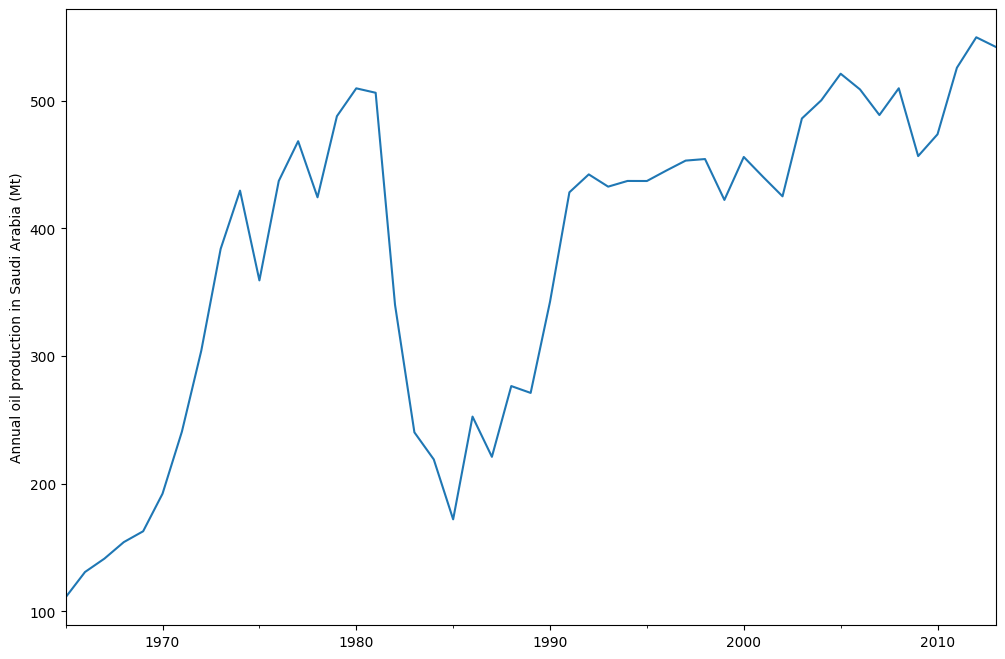
The plot above shows annual oil production in Saudi Arabia in million tonnes. The data are taken from the R package fpp2 (companion package to prior version [1]). Below you can see how to fit a simple exponential smoothing model using statsmodels’s ETS implementation to this data. Additionally, the fit using forecast in R is shown as comparison.
[4]:
model = ETSModel(oil)
fit = model.fit(maxiter=10000)
oil.plot(label="data")
fit.fittedvalues.plot(label="statsmodels fit")
plt.ylabel("Annual oil production in Saudi Arabia (Mt)")
# obtained from R
params_R = [0.99989969, 0.11888177503085334, 0.80000197, 36.46466837, 34.72584983]
yhat = model.smooth(params_R).fittedvalues
yhat.plot(label="R fit", linestyle="--")
plt.legend()
RUNNING THE L-BFGS-B CODE
* * *
Machine precision = 2.220D-16
N = 2 M = 10
At X0 0 variables are exactly at the bounds
At iterate 0 f= 6.27365D+00 |proj g|= 8.99900D-01
At iterate 1 f= 5.31675D+00 |proj g|= 6.49880D-04
At iterate 2 f= 5.30939D+00 |proj g|= 5.55467D-04
At iterate 3 f= 5.29115D+00 |proj g|= 5.87086D-05
At iterate 4 f= 5.29096D+00 |proj g|= 1.86518D-06
* * *
Tit = total number of iterations
Tnf = total number of function evaluations
Tnint = total number of segments explored during Cauchy searches
Skip = number of BFGS updates skipped
Nact = number of active bounds at final generalized Cauchy point
Projg = norm of the final projected gradient
F = final function value
* * *
N Tit Tnf Tnint Skip Nact Projg F
2 4 13 5 0 1 1.865D-06 5.291D+00
F = 5.2909564503744404
CONVERGENCE: NORM_OF_PROJECTED_GRADIENT_<=_PGTOL
[4]:
<matplotlib.legend.Legend at 0x7f19b560d990>
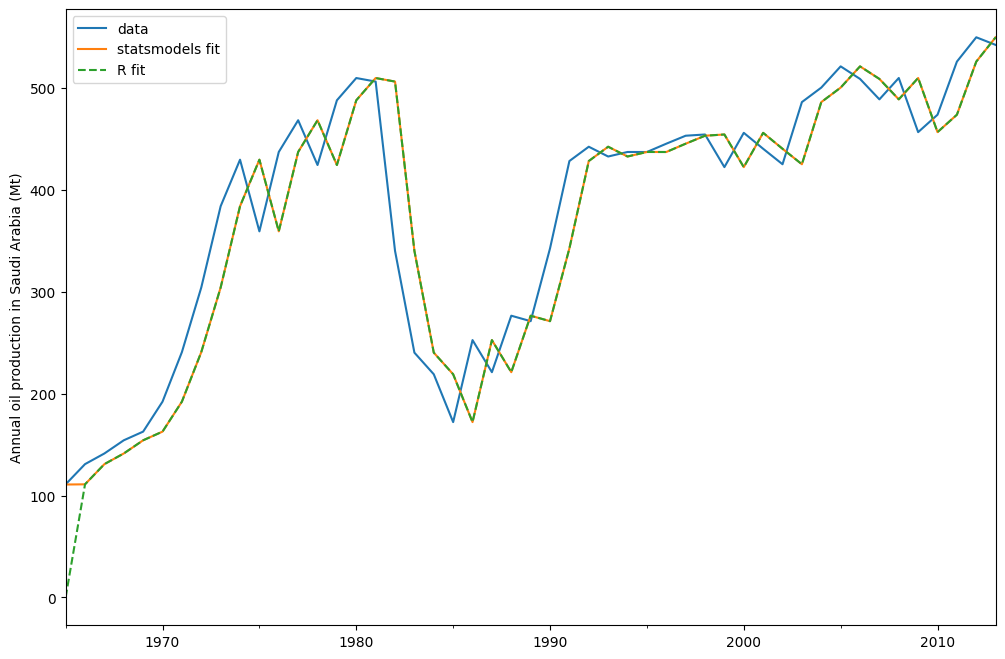
By default the initial states are considered to be fitting parameters and are estimated by maximizing log-likelihood. It is possible to only use a heuristic for the initial values:
[5]:
model_heuristic = ETSModel(oil, initialization_method="heuristic")
fit_heuristic = model_heuristic.fit()
oil.plot(label="data")
fit.fittedvalues.plot(label="estimated")
fit_heuristic.fittedvalues.plot(label="heuristic", linestyle="--")
plt.ylabel("Annual oil production in Saudi Arabia (Mt)")
# obtained from R
params = [0.99989969, 0.11888177503085334, 0.80000197, 36.46466837, 34.72584983]
yhat = model.smooth(params).fittedvalues
yhat.plot(label="with R params", linestyle=":")
plt.legend()
RUNNING THE L-BFGS-B CODE
* * *
Machine precision = 2.220D-16
N = 1 M = 10
At X0 0 variables are exactly at the bounds
At iterate 0 f= 6.27365D+00 |proj g|= 8.99900D-01
At iterate 1 f= 5.31675D+00 |proj g|= 0.00000D+00
* * *
Tit = total number of iterations
Tnf = total number of function evaluations
Tnint = total number of segments explored during Cauchy searches
Skip = number of BFGS updates skipped
Nact = number of active bounds at final generalized Cauchy point
Projg = norm of the final projected gradient
F = final function value
* * *
N Tit Tnf Tnint Skip Nact Projg F
1 1 2 1 0 1 0.000D+00 5.317D+00
F = 5.3167544390512402
CONVERGENCE: NORM_OF_PROJECTED_GRADIENT_<=_PGTOL
[5]:
<matplotlib.legend.Legend at 0x7f19b5491ab0>
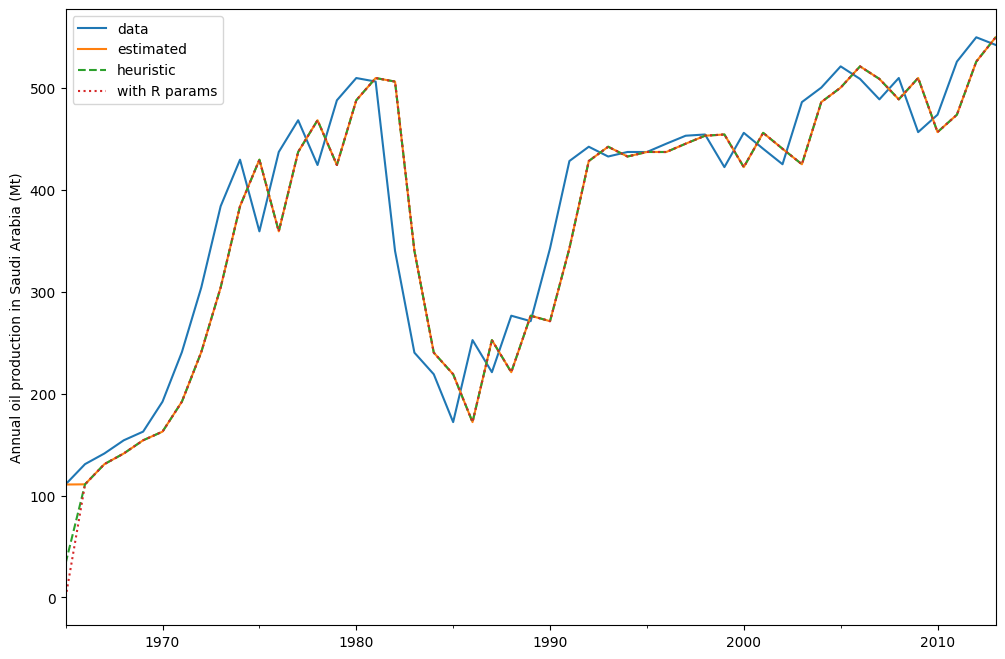
The fitted parameters and some other measures are shown using fit.summary(). Here we can see that the log-likelihood of the model using fitted initial states is fractionally lower than the one using a heuristic for the initial states.
[6]:
print(fit.summary())
ETS Results
==============================================================================
Dep. Variable: y No. Observations: 49
Model: ETS(ANN) Log Likelihood -259.257
Date: Wed, 02 Nov 2022 AIC 524.514
Time: 17:06:12 BIC 530.189
Sample: 01-01-1965 HQIC 526.667
- 01-01-2013 Scale 2307.767
Covariance Type: approx
===================================================================================
coef std err z P>|z| [0.025 0.975]
-----------------------------------------------------------------------------------
smoothing_level 0.9999 0.132 7.551 0.000 0.740 1.259
initial_level 110.7930 48.110 2.303 0.021 16.499 205.087
===================================================================================
Ljung-Box (Q): 1.87 Jarque-Bera (JB): 20.78
Prob(Q): 0.39 Prob(JB): 0.00
Heteroskedasticity (H): 0.49 Skew: -1.04
Prob(H) (two-sided): 0.16 Kurtosis: 5.42
===================================================================================
Warnings:
[1] Covariance matrix calculated using numerical (complex-step) differentiation.
[7]:
print(fit_heuristic.summary())
ETS Results
==============================================================================
Dep. Variable: y No. Observations: 49
Model: ETS(ANN) Log Likelihood -260.521
Date: Wed, 02 Nov 2022 AIC 525.042
Time: 17:06:12 BIC 528.826
Sample: 01-01-1965 HQIC 526.477
- 01-01-2013 Scale 2429.964
Covariance Type: approx
===================================================================================
coef std err z P>|z| [0.025 0.975]
-----------------------------------------------------------------------------------
smoothing_level 0.9999 0.132 7.559 0.000 0.741 1.259
==============================================
initialization method: heuristic
----------------------------------------------
initial_level 33.6309
===================================================================================
Ljung-Box (Q): 1.85 Jarque-Bera (JB): 18.42
Prob(Q): 0.40 Prob(JB): 0.00
Heteroskedasticity (H): 0.44 Skew: -1.02
Prob(H) (two-sided): 0.11 Kurtosis: 5.21
===================================================================================
Warnings:
[1] Covariance matrix calculated using numerical (complex-step) differentiation.
Holt-Winters’ seasonal method¶
The exponential smoothing method can be modified to incorporate a trend and a seasonal component. In the additive Holt-Winters’ method, the seasonal component is added to the rest. This model corresponds to the ETS(A, A, A) model, and has the following state space formulation:
[8]:
austourists_data = [
30.05251300,
19.14849600,
25.31769200,
27.59143700,
32.07645600,
23.48796100,
28.47594000,
35.12375300,
36.83848500,
25.00701700,
30.72223000,
28.69375900,
36.64098600,
23.82460900,
29.31168300,
31.77030900,
35.17787700,
19.77524400,
29.60175000,
34.53884200,
41.27359900,
26.65586200,
28.27985900,
35.19115300,
42.20566386,
24.64917133,
32.66733514,
37.25735401,
45.24246027,
29.35048127,
36.34420728,
41.78208136,
49.27659843,
31.27540139,
37.85062549,
38.83704413,
51.23690034,
31.83855162,
41.32342126,
42.79900337,
55.70835836,
33.40714492,
42.31663797,
45.15712257,
59.57607996,
34.83733016,
44.84168072,
46.97124960,
60.01903094,
38.37117851,
46.97586413,
50.73379646,
61.64687319,
39.29956937,
52.67120908,
54.33231689,
66.83435838,
40.87118847,
51.82853579,
57.49190993,
65.25146985,
43.06120822,
54.76075713,
59.83447494,
73.25702747,
47.69662373,
61.09776802,
66.05576122,
]
index = pd.date_range("1999-03-01", "2015-12-01", freq="3MS")
austourists = pd.Series(austourists_data, index=index)
austourists.plot()
plt.ylabel("Australian Tourists")
[8]:
Text(0, 0.5, 'Australian Tourists')
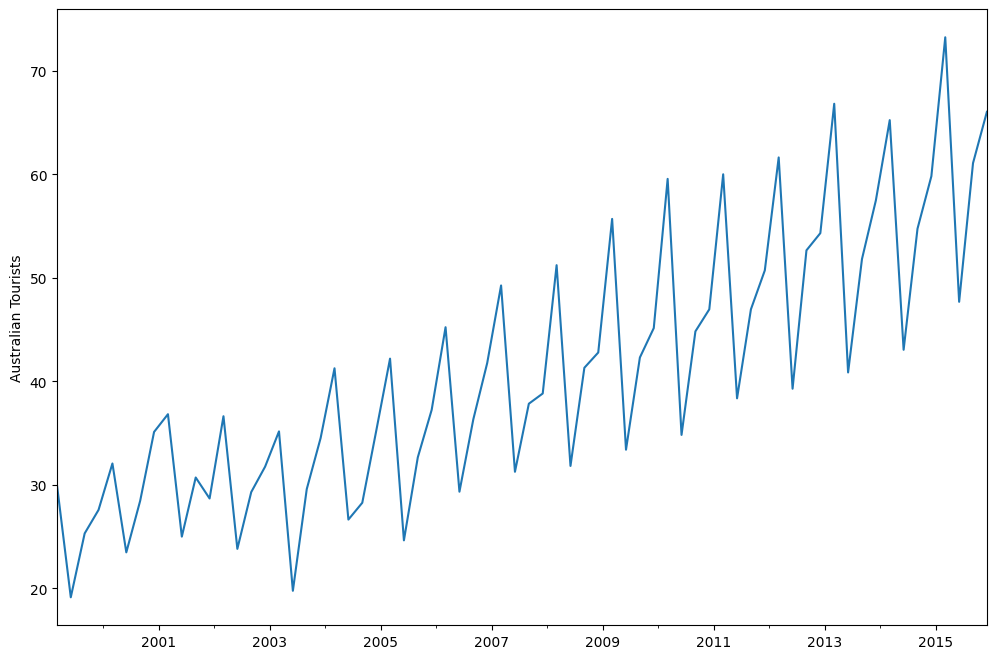
[9]:
# fit in statsmodels
model = ETSModel(
austourists,
error="add",
trend="add",
seasonal="add",
damped_trend=True,
seasonal_periods=4,
)
fit = model.fit()
# fit with R params
params_R = [
0.35445427,
0.03200749,
0.39993387,
0.97999997,
24.01278357,
0.97770147,
1.76951063,
-0.50735902,
-6.61171798,
5.34956637,
]
fit_R = model.smooth(params_R)
austourists.plot(label="data")
plt.ylabel("Australian Tourists")
fit.fittedvalues.plot(label="statsmodels fit")
fit_R.fittedvalues.plot(label="R fit", linestyle="--")
plt.legend()
RUNNING THE L-BFGS-B CODE
* * *
Machine precision = 2.220D-16
N = 9 M = 10
At X0 1 variables are exactly at the bounds
At iterate 0 f= 3.40132D+00 |proj g|= 9.88789D-01
At iterate 1 f= 2.58255D+00 |proj g|= 9.99244D-01
At iterate 2 f= 2.49918D+00 |proj g|= 2.90033D-01
At iterate 3 f= 2.48198D+00 |proj g|= 2.44942D-01
At iterate 4 f= 2.43118D+00 |proj g|= 7.29715D-02
At iterate 5 f= 2.42924D+00 |proj g|= 7.03572D-02
At iterate 6 f= 2.42851D+00 |proj g|= 4.66401D-02
At iterate 7 f= 2.42794D+00 |proj g|= 2.92420D-02
At iterate 8 f= 2.42784D+00 |proj g|= 2.53311D-02
At iterate 9 f= 2.42721D+00 |proj g|= 1.89532D-02
At iterate 10 f= 2.42622D+00 |proj g|= 3.18651D-02
At iterate 11 f= 2.42512D+00 |proj g|= 3.53011D-02
At iterate 12 f= 2.42383D+00 |proj g|= 3.65638D-02
At iterate 13 f= 2.42196D+00 |proj g|= 4.83560D-02
At iterate 14 f= 2.41828D+00 |proj g|= 5.99631D-02
At iterate 15 f= 2.41131D+00 |proj g|= 6.89763D-02
At iterate 16 f= 2.40200D+00 |proj g|= 7.65493D-02
At iterate 17 f= 2.39385D+00 |proj g|= 8.77260D-02
At iterate 18 f= 2.37917D+00 |proj g|= 1.52245D-01
At iterate 19 f= 2.35438D+00 |proj g|= 2.40363D-01
At iterate 20 f= 2.33832D+00 |proj g|= 2.53143D-01
At iterate 21 f= 2.33774D+00 |proj g|= 2.54902D-01
At iterate 22 f= 2.33766D+00 |proj g|= 2.49994D-01
At iterate 23 f= 2.33766D+00 |proj g|= 2.50104D-01
Positive dir derivative in projection
Using the backtracking step
At iterate 24 f= 2.32726D+00 |proj g|= 2.22975D-01
At iterate 25 f= 2.29784D+00 |proj g|= 1.16941D-01
At iterate 26 f= 2.29783D+00 |proj g|= 1.19878D-01
At iterate 27 f= 2.29783D+00 |proj g|= 1.21984D-01
At iterate 28 f= 2.29781D+00 |proj g|= 1.25790D-01
At iterate 29 f= 2.29113D+00 |proj g|= 8.44534D-02
At iterate 30 f= 2.27689D+00 |proj g|= 2.30209D-01
At iterate 31 f= 2.27528D+00 |proj g|= 1.25984D-01
At iterate 32 f= 2.27316D+00 |proj g|= 6.97733D-02
At iterate 33 f= 2.27205D+00 |proj g|= 2.60402D-02
At iterate 34 f= 2.27180D+00 |proj g|= 1.96301D-02
At iterate 35 f= 2.27153D+00 |proj g|= 4.38765D-03
At iterate 36 f= 2.27146D+00 |proj g|= 4.78666D-03
At iterate 37 f= 2.27062D+00 |proj g|= 2.37355D-02
At iterate 38 f= 2.26946D+00 |proj g|= 3.82704D-02
At iterate 39 f= 2.26699D+00 |proj g|= 4.70319D-02
At iterate 40 f= 2.26462D+00 |proj g|= 3.43058D-02
At iterate 41 f= 2.26203D+00 |proj g|= 2.18685D-02
At iterate 42 f= 2.26006D+00 |proj g|= 2.83495D-02
At iterate 43 f= 2.25881D+00 |proj g|= 4.32037D-02
At iterate 44 f= 2.25609D+00 |proj g|= 4.94953D-02
At iterate 45 f= 2.25369D+00 |proj g|= 1.20176D-01
At iterate 46 f= 2.25097D+00 |proj g|= 2.60216D-02
At iterate 47 f= 2.24903D+00 |proj g|= 3.29519D-02
At iterate 48 f= 2.24813D+00 |proj g|= 4.94365D-02
At iterate 49 f= 2.24642D+00 |proj g|= 4.11819D-02
At iterate 50 f= 2.24591D+00 |proj g|= 3.68314D-02
At iterate 51 f= 2.24526D+00 |proj g|= 1.04519D-02
At iterate 52 f= 2.24519D+00 |proj g|= 2.51985D-03
At iterate 53 f= 2.24519D+00 |proj g|= 2.27445D-03
At iterate 54 f= 2.24517D+00 |proj g|= 5.45697D-03
At iterate 55 f= 2.24516D+00 |proj g|= 1.00389D-02
At iterate 56 f= 2.24512D+00 |proj g|= 1.65810D-02
At iterate 57 f= 2.24506D+00 |proj g|= 1.84056D-02
At iterate 58 f= 2.24493D+00 |proj g|= 1.66877D-02
At iterate 59 f= 2.24475D+00 |proj g|= 1.22406D-02
At iterate 60 f= 2.24455D+00 |proj g|= 3.20739D-03
At iterate 61 f= 2.24452D+00 |proj g|= 1.36433D-03
At iterate 62 f= 2.24452D+00 |proj g|= 1.45146D-03
At iterate 63 f= 2.24452D+00 |proj g|= 9.39737D-04
At iterate 64 f= 2.24452D+00 |proj g|= 9.74687D-04
At iterate 65 f= 2.24452D+00 |proj g|= 6.42419D-04
At iterate 66 f= 2.24452D+00 |proj g|= 3.26539D-04
At iterate 67 f= 2.24452D+00 |proj g|= 3.99325D-04
At iterate 68 f= 2.24452D+00 |proj g|= 7.01572D-04
At iterate 69 f= 2.24452D+00 |proj g|= 1.01759D-03
At iterate 70 f= 2.24452D+00 |proj g|= 1.39750D-03
At iterate 71 f= 2.24451D+00 |proj g|= 1.67200D-03
At iterate 72 f= 2.24451D+00 |proj g|= 1.42490D-03
At iterate 73 f= 2.24451D+00 |proj g|= 1.05196D-03
At iterate 74 f= 2.24451D+00 |proj g|= 4.36984D-04
At iterate 75 f= 2.24451D+00 |proj g|= 1.07470D-04
At iterate 76 f= 2.24451D+00 |proj g|= 1.10312D-04
At iterate 77 f= 2.24451D+00 |proj g|= 1.12932D-04
At iterate 78 f= 2.24451D+00 |proj g|= 7.29194D-05
At iterate 79 f= 2.24451D+00 |proj g|= 5.37348D-05
At iterate 80 f= 2.24451D+00 |proj g|= 9.29035D-05
At iterate 81 f= 2.24451D+00 |proj g|= 1.07736D-04
At iterate 82 f= 2.24451D+00 |proj g|= 2.11209D-04
At iterate 83 f= 2.24451D+00 |proj g|= 2.05702D-04
At iterate 84 f= 2.24451D+00 |proj g|= 9.85434D-05
At iterate 85 f= 2.24451D+00 |proj g|= 6.38600D-05
At iterate 86 f= 2.24451D+00 |proj g|= 1.66445D-04
At iterate 87 f= 2.24451D+00 |proj g|= 1.44196D-04
At iterate 88 f= 2.24451D+00 |proj g|= 2.32481D-04
At iterate 89 f= 2.24451D+00 |proj g|= 2.30749D-04
At iterate 90 f= 2.24451D+00 |proj g|= 1.80833D-04
At iterate 91 f= 2.24451D+00 |proj g|= 9.96536D-05
At iterate 92 f= 2.24451D+00 |proj g|= 4.37872D-05
* * *
Tit = total number of iterations
Tnf = total number of function evaluations
Tnint = total number of segments explored during Cauchy searches
Skip = number of BFGS updates skipped
Nact = number of active bounds at final generalized Cauchy point
Projg = norm of the final projected gradient
F = final function value
* * *
N Tit Tnf Tnint Skip Nact Projg F
9 92 113 100 0 1 4.379D-05 2.245D+00
F = 2.2445125684008076
CONVERGENCE: REL_REDUCTION_OF_F_<=_FACTR*EPSMCH
[9]:
<matplotlib.legend.Legend at 0x7f19b0f4add0>
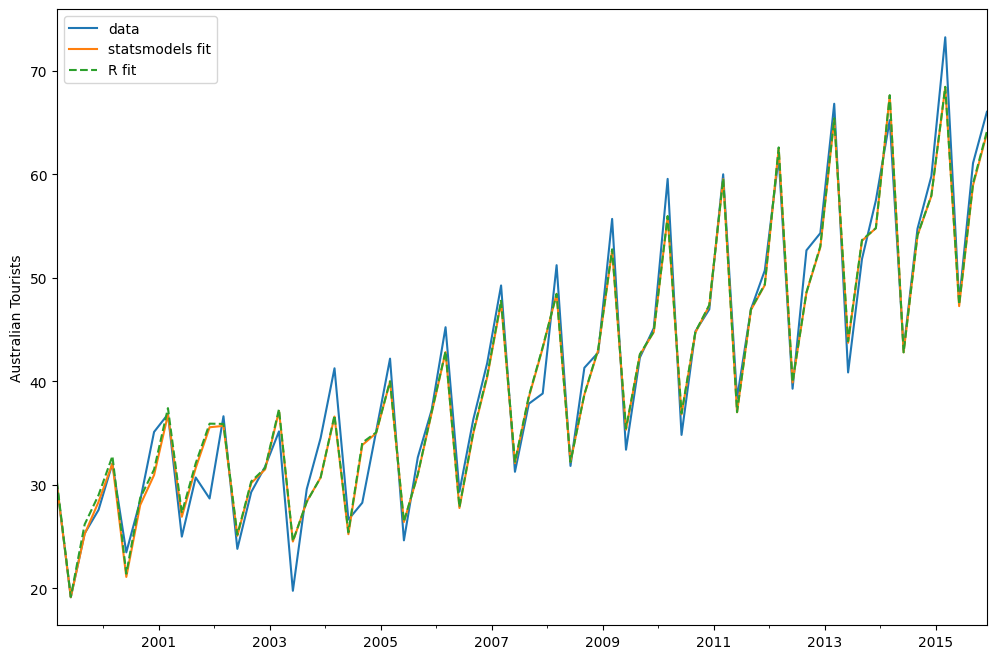
[10]:
print(fit.summary())
ETS Results
==============================================================================
Dep. Variable: y No. Observations: 68
Model: ETS(AAdA) Log Likelihood -152.627
Date: Wed, 02 Nov 2022 AIC 327.254
Time: 17:06:13 BIC 351.668
Sample: 03-01-1999 HQIC 336.928
- 12-01-2015 Scale 5.213
Covariance Type: approx
======================================================================================
coef std err z P>|z| [0.025 0.975]
--------------------------------------------------------------------------------------
smoothing_level 0.3398 0.111 3.070 0.002 0.123 0.557
smoothing_trend 0.0259 0.008 3.158 0.002 0.010 0.042
smoothing_seasonal 0.4011 0.080 5.041 0.000 0.245 0.557
damping_trend 0.9800 nan nan nan nan nan
initial_level 29.4435 2.82e+04 0.001 0.999 -5.52e+04 5.52e+04
initial_trend 0.6142 0.392 1.565 0.118 -0.155 1.383
initial_seasonal.0 -3.4340 2.82e+04 -0.000 1.000 -5.52e+04 5.52e+04
initial_seasonal.1 -5.9537 2.82e+04 -0.000 1.000 -5.52e+04 5.52e+04
initial_seasonal.2 -11.4807 2.82e+04 -0.000 1.000 -5.52e+04 5.52e+04
initial_seasonal.3 0 2.82e+04 0 1.000 -5.52e+04 5.52e+04
===================================================================================
Ljung-Box (Q): 5.76 Jarque-Bera (JB): 7.70
Prob(Q): 0.67 Prob(JB): 0.02
Heteroskedasticity (H): 0.46 Skew: -0.63
Prob(H) (two-sided): 0.07 Kurtosis: 4.05
===================================================================================
Warnings:
[1] Covariance matrix calculated using numerical (complex-step) differentiation.
Predictions¶
The ETS model can also be used for predicting. There are several different methods available: - forecast: makes out of sample predictions - predict: in sample and out of sample predictions - simulate: runs simulations of the statespace model - get_prediction: in sample and out of sample predictions, as well as prediction intervals
We can use them on our previously fitted model to predict from 2014 to 2020.
[11]:
pred = fit.get_prediction(start="2014", end="2020")
[12]:
df = pred.summary_frame(alpha=0.05)
df
[12]:
| mean | pi_lower | pi_upper | |
|---|---|---|---|
| 2014-03-01 | 67.611079 | 63.136107 | 72.086051 |
| 2014-06-01 | 42.814677 | 38.339705 | 47.289649 |
| 2014-09-01 | 54.106487 | 49.631515 | 58.581459 |
| 2014-12-01 | 57.928408 | 53.453435 | 62.403380 |
| 2015-03-01 | 68.422018 | 63.947046 | 72.896990 |
| 2015-06-01 | 47.277788 | 42.802816 | 51.752760 |
| 2015-09-01 | 58.954778 | 54.479806 | 63.429750 |
| 2015-12-01 | 63.982304 | 59.507332 | 68.457277 |
| 2016-03-01 | 75.905406 | 71.430433 | 80.380378 |
| 2016-06-01 | 51.418127 | 46.654024 | 56.182229 |
| 2016-09-01 | 63.703395 | 58.629499 | 68.777291 |
| 2016-12-01 | 67.978296 | 62.575966 | 73.380625 |
| 2017-03-01 | 78.315993 | 71.735938 | 84.896048 |
| 2017-06-01 | 53.780502 | 46.883518 | 60.677487 |
| 2017-09-01 | 66.018523 | 58.788390 | 73.248656 |
| 2017-12-01 | 70.247121 | 62.668984 | 77.825259 |
| 2018-03-01 | 80.539442 | 71.892906 | 89.185979 |
| 2018-06-01 | 55.959483 | 46.968321 | 64.950644 |
| 2018-09-01 | 68.153924 | 58.805365 | 77.502483 |
| 2018-12-01 | 72.339814 | 62.622088 | 82.057540 |
| 2019-03-01 | 82.590281 | 71.864871 | 93.315692 |
| 2019-06-01 | 57.969305 | 46.875993 | 69.062616 |
| 2019-09-01 | 70.123549 | 58.652213 | 81.594886 |
| 2019-12-01 | 74.270047 | 62.411331 | 86.128764 |
| 2020-03-01 | 84.481910 | 71.656489 | 97.307330 |
In this case the prediction intervals were calculated using an analytical formula. This is not available for all models. For these other models, prediction intervals are calculated by performing multiple simulations (1000 by default) and using the percentiles of the simulation results. This is done internally by the get_prediction method.
We can also manually run simulations, e.g. to plot them. Since the data ranges until end of 2015, we have to simulate from the first quarter of 2016 to the first quarter of 2020, which means 17 steps.
[13]:
simulated = fit.simulate(anchor="end", nsimulations=17, repetitions=100)
[14]:
for i in range(simulated.shape[1]):
simulated.iloc[:, i].plot(label="_", color="gray", alpha=0.1)
df["mean"].plot(label="mean prediction")
df["pi_lower"].plot(linestyle="--", color="tab:blue", label="95% interval")
df["pi_upper"].plot(linestyle="--", color="tab:blue", label="_")
pred.endog.plot(label="data")
plt.legend()
[14]:
<matplotlib.legend.Legend at 0x7f19b0b13d60>
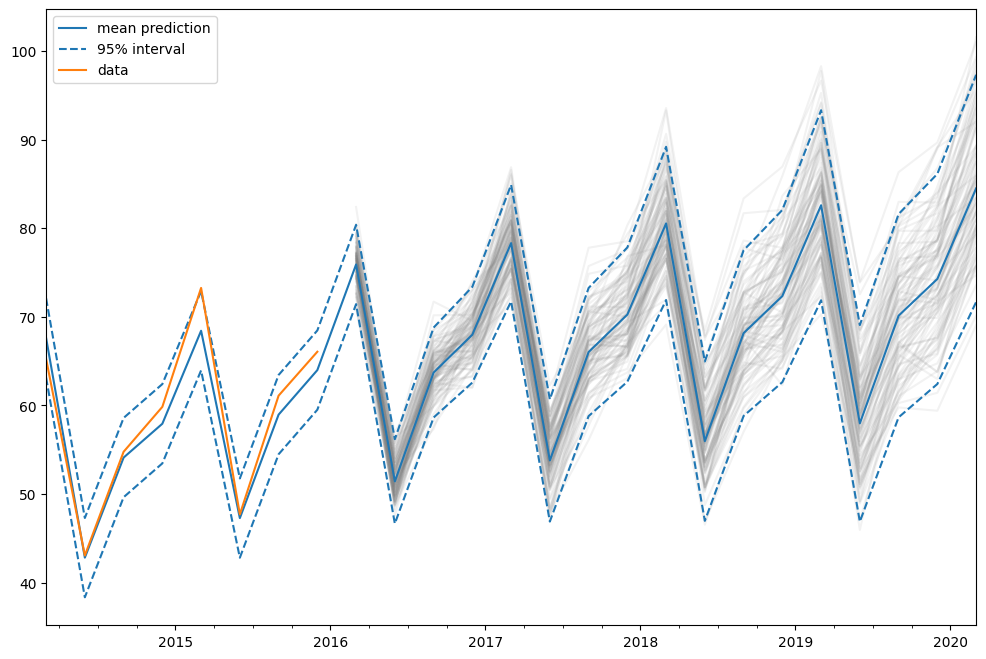
In this case, we chose “end” as simulation anchor, which means that the first simulated value will be the first out of sample value. It is also possible to choose other anchor inside the sample.